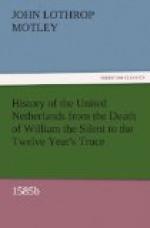The country in this neighbourhood was low, spongy, full of creeks, small meres, and the old bed of the Scheldt. Orange, therefore, made it very clear, that by piercing the great dyke just described, such a vast body of water would be made to pour over the land as to submerge the Kowenstyn also, the only other obstacle in the passage of fleets from Zeeland to Antwerp. The city would then be connected with the sea and its islands, by so vast an expanse of navigable water, that any attempt on Parma’s part to cut off supplies and succour would be hopeless. Antwerp would laugh the idea of famine to scorn; and although this immunity would be purchased by the sacrifice of a large amount of agricultural territory the price so paid was but a slender one, when the existence of the capital, and with it perhaps of the whole confederacy was at stake.
Sainte Aldegonde and Martini suggested, that, as there would be some opposition to the measure proposed, it might be as well to make a similar attempt on the Flemish side, in preference, by breaking through the dykes in the neighbourhood of Saftingen. Orange replied, by demonstrating that the land in the region which he had indicated was of a character to ensure success, while in the other direction there were certain very unfavourable circumstances which rendered the issue doubtful. The result was destined to prove the sagacity of the Prince, for it will be shown in the sequel, that the Saftingen plan, afterwards really carried out, was rather advantageous than detrimental to the enemy’s projects.
Sainte Aldegonde, accordingly, yielded to the arguments and entreaties of his friend, and repaired without delay to Antwerp.
The advice of William the Silent—as will soon be related—was not acted upon; and, within a few weeks after it had been given, he was in his grave. Nowhere was his loss more severely felt than in Antwerp. It seemed, said a contemporary, that with his death had died all authority. The Prince was the only head which the many-membered body of that very democratic city ever spontaneously obeyed. Antwerp was a small republic —in time of peace intelligently and successfully administered—which in the season of a great foreign war, amid plagues, tumults, famine, and internal rebellion, required the firm hand and the clear brain of a single chief. That brain and hand had been possessed by Orange alone.
Before his death he had desired that Sainte Aldegonde should accept the office of burgomaster of the city. Nominally, the position was not so elevated as were many of the posts which that distinguished patriot had filled. In reality, it was as responsible and arduous a place as could be offered to any man’s acceptance throughout the country. Sainte Aldegonde consented, not without some reluctance. He felt that there was odium to be incurred; he knew that much would be expected of him, and that his means would be limited. His powers would be liable to a constant and various restraint. His measures were sure to be the subject of perpetual cavil. If the city were besieged, there were nearly one hundred thousand mouths to feed, and nearly one hundred thousand tongues to dispute about furnishing the food.




